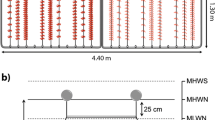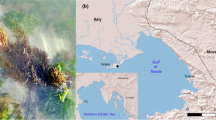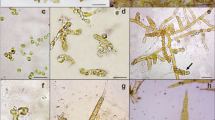Abstract
Codium fragile (Suringar) Hariot is an edible green alga farmed in Korea using seed stock produced from regeneration of isolated utricles and medullary filaments. Experiments were conducted to reveal the optimal conditions for nursery culture and out-growing of C. fragile. Sampling and measurement of underwater irradiance were carried out at farms cultivating C. fragile at Wando, on the southwestern coast of Korea, from October 2004 to August 2005. Growth of erect thalli and underwater irradiance were measured over a range of depths for three culture stages. During the nursery cultivation stage (Stage I), growth rate was greatest at 0.5 m depth (0.055 ± 0.032 mm day−1), where the average midday irradiance over 60 days was 924 ± 32 μmol photons m−2 s−1. During the pre-main cultivation stage (Stage II), the greatest growth rate occurred at a depth of 2 m (0.113 ± 0.003 mm day−1) with an average irradiance of 248 ± 116 μmol photons m−2 s−1. For the main cultivation stage (Stage III) of the alga, thalli achieved the greatest increase in biomass at 1 m depth (7.2 ± 1.0 kg fresh wt m−1). These results suggest that optimal growth at each cultivation stages of C. fragile could be controlled by depth of cultivation rope.




Similar content being viewed by others
References
Abbott IA (1988) Food and food products from seaweeds. In: Lembi CA, Waaland JR (eds) Algae and human affairs. Cambridge Univ Press, New York, pp 135–147
Arasaki S, Tokuda H, Fujiyama K (1956) The reproduction and morphogeny in Codium fragile. Bot Mag Tokyo 69:39–44
Borden CA, Stein JR (1969) Reproduction and early development in Codium fragile (Suringar) Hariot: Chlorophyceae. Phycologia 8:91–99
Carruthers TJB, Longstaff BJ, Dennison WC, Abal EG, Aioi K (2001) Measurement of light penetration in relation to seagrass. In: Short FT, Coles RG (eds) Global seagrass research methods. Elsevier, Amsterdam, pp 369–392
Fletcher RL, Blunden G, Smith BE, Rogers DJ, Fish BC (1989) Occurrence of fouling, juvenile stage of Codium fragile ssp. tomentosoides (Goor) Silva (Chlorophyceae, Codiales). J Appl Phycol 1:227–237
Hanisak MD (1979) Physiological ecology of Codium fragile subsp. tomentosoides. PhD Thesis, University of Rhode Island
Hwang EK, Baek JM, Park CS (2005a) Artificial seed production using the reproduction methods in Codium fragile (Chlorophyta). J Korean Fish Soc 38:164–171
Hwang EK, Baek JM, Park CS (2005b) Artificial seed production and nursery culture conditions using regeneration of isolated utricles and medullary filaments of Codium fragile (Suringar) Hariot. J Korean Fish Soc 38:393–398
Kenworthy WJ, Fonseca MS (1996) Light requirements of seagrasses Halodule wrightii and Syringodium filiforme derived from the relationship between diffuse light attenuation and maximum depth distribution. Estuaries 19:740–750
Nanba N, Kado R, Ogawa H, Nakagawa, Komuro (2002) Formation and growth of filamentous thalli from isolated utricles with medullary filaments of Codium fragile spongy thalli. Aquat Bot 73:255–264
Nanba N, Kado R, Ogawa H, Nakagawa T, Sugiura Y (2005) Effects of irradiance and water flow on formation and growth of spongy and filamentous thalli of Codium fragile. Aquat Bot 81:315–325
Park CS, Sohn CH (1992) Effects of light and temperature on morphogenesis of Codium fragile (Suringar) Hariot in laboratory culture. Korean J Phycol 7:213–223
Ramus J (1972) Differentiation of the green alga Codium fragile. Am J Bot 59:478–482
Silva PC, Womersley HBS (1956) The genus Codium (Chlorophyta) in southern Australia. Aust J Bot 4:261–289
Sohn CH (1998) The seaweed resources of Korea. In: Critchley AT, Ohno M (eds), Seaweed resources of the world. Jap Int Coop Agency, pp 15–33
Sohn CH, Kain (Jones) JM (1989) Undaria, Laminaria and Enteromorpha cultivation in Korea. In: Kain (Jones) JM, Andrews JW, McGregor BJ (eds) Proceedings of the 2nd Workshop of COST 48 Subgroup 1. Port Erin, Isle of Man, British Isles, 1989
Trowbridge CD (1998) Ecology of the green macroalga Codium fragile (Suringar) Hariot 1989: invasive and non-invasive subspecies. Annu Rev Oceanogr Mar Biol 36:1–64
Yang MH, Blunden G, Huang FL, Fletcher RL (1997) Growth of dissociated, filamentous stage of Codium species in laboratory culture. J Appl Phycol 9:1–3
Yoshida T (1998) Marine algae of Japan. Uchida Rokakuho, Tokyo
Acknowledgments
This research was supported by a grant (F10400706A210000100) from the Fisheries Technology Development Program funded by Ministry of Maritime Affairs & Fisheries of Korean government and National Fisheries Research & Development Institute (RP-2007-AQ-025). We thank Dr. Phillip Heath (NIWA, New Zealand) for reviewing the English.
Author information
Authors and Affiliations
Corresponding author
Rights and permissions
About this article
Cite this article
Hwang, E.K., Baek, J.M. & Park, C.S. Cultivation of the green alga, Codium fragile (Suringar) Hariot, by artificial seed production in Korea. J Appl Phycol 20, 469–475 (2008). https://doi.org/10.1007/s10811-007-9265-5
Received:
Revised:
Accepted:
Published:
Issue Date:
DOI: https://doi.org/10.1007/s10811-007-9265-5




